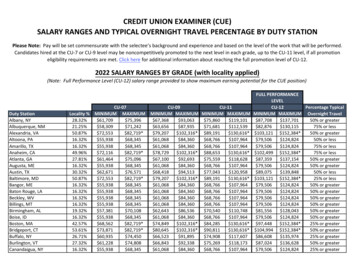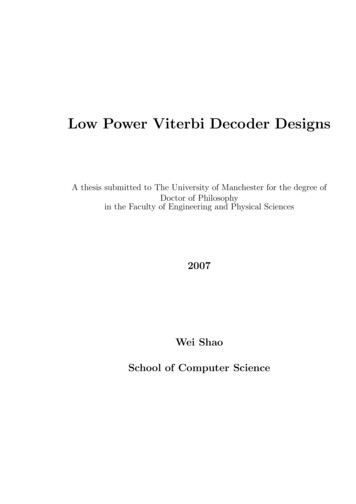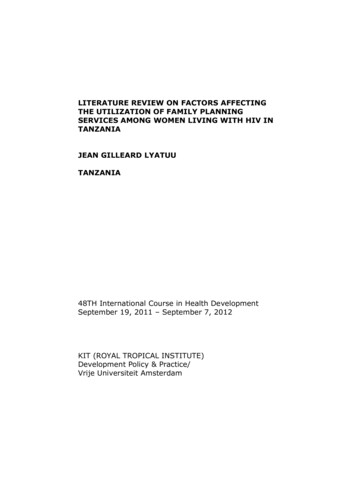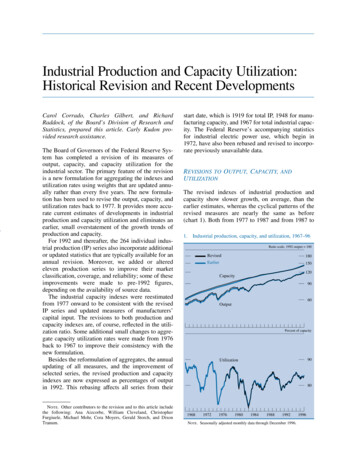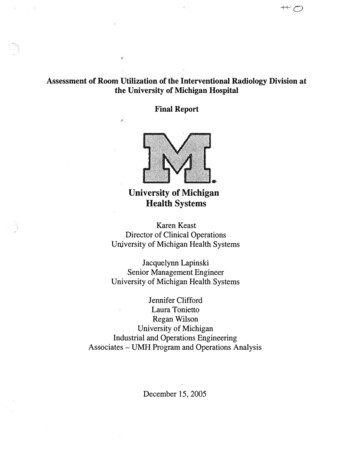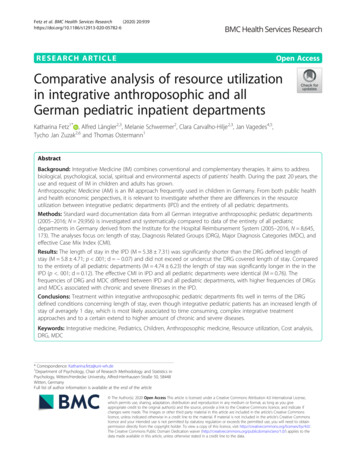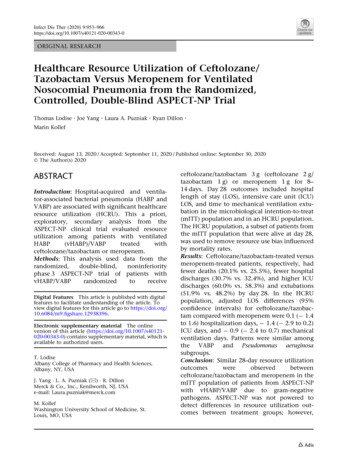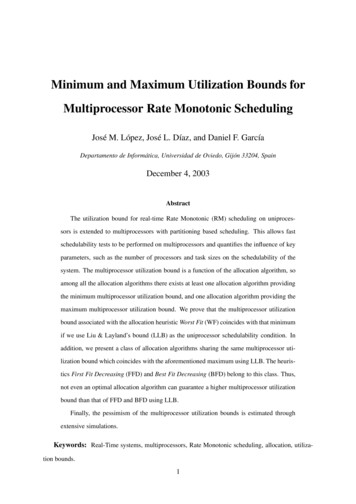
Transcription
Minimum and Maximum Utilization Bounds forMultiprocessor Rate Monotonic SchedulingJosé M. López, José L. Dı́az, and Daniel F. Garcı́aDepartamento de Informática, Universidad de Oviedo, Gijón 33204, SpainDecember 4, 2003AbstractThe utilization bound for real-time Rate Monotonic (RM) scheduling on uniprocessors is extended to multiprocessors with partitioning based scheduling. This allows fastschedulability tests to be performed on multiprocessors and quantifies the influence of keyparameters, such as the number of processors and task sizes on the schedulability of thesystem. The multiprocessor utilization bound is a function of the allocation algorithm, soamong all the allocation algorithms there exists at least one allocation algorithm providingthe minimum multiprocessor utilization bound, and one allocation algorithm providing themaximum multiprocessor utilization bound. We prove that the multiprocessor utilizationbound associated with the allocation heuristic Worst Fit (WF) coincides with that minimumif we use Liu & Layland’s bound (LLB) as the uniprocessor schedulability condition. Inaddition, we present a class of allocation algorithms sharing the same multiprocessor utilization bound which coincides with the aforementioned maximum using LLB. The heuristics First Fit Decreasing (FFD) and Best Fit Decreasing (BFD) belong to this class. Thus,not even an optimal allocation algorithm can guarantee a higher multiprocessor utilizationbound than that of FFD and BFD using LLB.Finally, the pessimism of the multiprocessor utilization bounds is estimated throughextensive simulations.Keywords: Real-Time systems, multiprocessors, Rate Monotonic scheduling, allocation, utilization bounds.1
1 IntroductionMultiprocessor scheduling is a challenging problem in the real-time systems theory. Thereare two main strategies when dealing with this problem: partitioning strategies and globalstrategies [1]. In a partitioning strategy, once a task is allocated to a processor, all of its instancesare executed exclusively on that processor. In a global strategy, any instance of a task can beexecuted on any processor, or even be pre-empted and moved to a different processor, before itis completed.Theoretically, global strategies provide higher schedulability than partitioning strategies.However, partitioning strategies have several advantages over global strategies. Firstly, thescheduling overhead associated with partitioning strategies is lower than that of global strategies. Secondly, partitioning strategies allow well known uniprocessor scheduling algorithmsto be applied on each processor. Furthermore, Rate Monotonic (RM) and Earliest DeadlineFirst (EDF) scheduling, which are optimal real-time uniprocessor scheduling algorithms [2],perform poorly when extended to global multiprocessor scheduling. The utilization boundsassociated with global RM or EDF multiprocessor scheduling are not higher than one for anynumber of processors [3]. Nevertheless, these bounds can be greatly improved by placing restrictions on the tasks sizes, or by using some variations of global RM or EDF schedulingalgorithms [4, 5].In this article, we use the partitioning strategy, i.e, any task must always be executed onthe same processor. Tasks are pre-emptively scheduled on each processor according to theRM algorithm. RM is a static priority scheduling algorithm that assigns each task a priorityinversely proportional to its period, i.e, the smaller the period, the higher the priority. Thus, theallocation algorithm is the only degree of freedom in the system.Finding optimal allocation algorithms is not practical, as the problem is NP-hard in thestrong sense [6]. Several allocation algorithms have been proposed in the literature: simpleallocation heuristics [3, 6, 7] and complex allocation algorithms such as those based on branchand-bound [8] and simulated annealing techniques [9]. In this article, we focus on simpleallocation heuristics.Two different approaches are followed in the literature to establish the schedulability associated with a given allocation algorithm: simulation approaches and theoretical approaches.2
In the simulation approach, task sets are randomly generated. Next, the average number ofprocessors required to allocate task sets of a given total utilization is obtained. Uniprocessorexact tests [10], or uniprocessor sufficient tests [11] are commonly used to decide whether agiven group of tasks fits into one processor. Nevertheless, simulation results should be considered carefully, since randomly generated task sets may not be representative of those thatappear in practice.The traditional theoretical approach focuses on the calculation of bounds for the metric(NAA /NOPT ), for (uniprocessor scheduling algorithm, allocation algorithm) pairs [1, 3, 6, 7,12, 13]. This metric gives the relationship between the number of processors required to schedule a task set using a given allocation algorithm AA, and the number of processors requiredusing an optimal allocation algorithm OPT. This metric is useful in order to compare differentallocation algorithms, but not to perform schedulability tests. There are several reasons for this.Firstly, NOPT can not be calculated in polynomial time. Secondly, even if NOPT were known,the utilization bound derived from the metric would be too pessimistic [14]. For example, forFirst Fit (FF) allocation (NFF/NOPT ) 2.33, as proved in [1]. A task set made up of 20 tasks,each with a utilization factor (0.04 ε ), may require two processors to be schedulable evenusing an optimal allocation algorithm, since LLB for 20 tasks is 0.7, less than the total utilization, 20(0.04 ε ). Using the relation (NFF /NOPT ) 2.33, five processors would be necessaryto guarantee the schedulability of the task set using the FF allocation. This gives a utilizationbound not higher than 0.8/5 0.16 per processor, too low to be useful. Oh and Son [1] refined the relation (NFF /NOPT ) by considering the task sizes. Even so, the schedulability resultsobtained from these relations are too pessimistic when compared to the tight utilization bounds.A new theoretical approach consists of calculating the utilization bounds associated with(scheduling algorithm, allocation algorithm) pairs, analogous to those known for uniprocessors. This approach has several interesting features: it allows us to carry out fast schedulabilitytests, and to quantify the influence of certain parameters, such as the number of processors,on schedulability. The major disadvantage of this approach is the sufficient but not necessarycharacter of the associated schedulability tests. This approach was followed in [14] to obtainRM-FF for multiprocessor RM schedulinga lower limit, given by (1), on the utilization bound Uwc3
with First Fit allocation (FF).RM-FFUwc(n) n(21/2 1)(1)where n is the number of processors. From a practical point of view, Equation (1) states thatany task set of total utilization less than 0.414n is schedulable in a multiprocessor made upof n processors using FF allocation and RM scheduling on each processor. The reader shouldcompare the 0.414 utilization bound per processor with the utilization bound 0.16 per processor,obtained from relation (NFF /NOPT ).More recently, a tighter utilization bound for RM scheduling and FF allocation was presented in [15]. This bound considers not only the number of processors, but also the number oftasks and their sizes. The performance of the allocation algorithms depends largely on the tasksizes. Thus, it is usual to place some kind of limit on the task sizes, e.g a maximum utilizationfactor, to improve the theoretical results [1].The theoretical approach based on calculating utilizations bounds has also been developedrecently for global multiprocessor RM scheduling. Under global RM scheduling, Anderssonet al. [4] proved that the utilization bound is n2 /(3n 2), when the utilization factor of anytask is not higher than n/(3n 2). They also present a variation of the global RM schedulingalgorithm with the same utilization bound, n2 /(3n 2), but without the previous restriction ontask sizes. In addition, Baruah and Goossens [16] presented a generalization of the utilizationbound for global RM scheduling by considering the case of uniform multiprocessors, i.e, theyconsider the possibility of multiprocessors made up of non-identical processors.Our work makes the following theoretical contributions to the real-time multiprocessorschedulability analysis: The minimum utilization bound based on Liu & Layland’s bound (LLB) evaluated amongall the reasonable allocation algorithms is found. Reasonable allocation algorithms arethose which fail to allocate a task only when there is no processor in the system withsufficient free capacity to hold the task [17]. Using LLB, a reasonable allocation algorithm is one that fails to allocate a task only when there is no processor in the systemable to hold the task without violating LLB. The idea of restricting the study to reasonable allocation algorithms is to exclude theoretically possible, but impractical allocation4
algorithms, which would only complicate the mathematical description of the problem.In particular, the allocation heuristic Worst First (WF) provides this minimum utilizationbound using LLB. A class of reasonable allocation algorithms, termed Reasonable Allocation Decreasing(RAD), is defined. These algorithms are proved to provide the maximum utilizationbound using LLB among all the allocation algorithms (reasonable or not) for multiprocessor RM scheduling. The simple heuristics First Fit Decreasing (FFD) and Best FitDecreasing (BFD), described in [6], belong to this class. Thus, not even an optimal allocation algorithm can provide a higher multiprocessor utilization bound than that of FFDand BFD using LLB.The rest of the article is organized as follows. Section 2 defines the computational systemused. The minimum and maximum utilization bounds for multiprocessor RM scheduling usingLLB are provided in Section 3. Section 4 presents the Worst Fit allocation heuristic (WF) andcalculates its utilization bound, which coincides with the minimum using LLB. Section 5 provesthe expression of the utilization bound for RAD allocation, which coincides with the maximumusing LLB. The mathematical expressions of the minimum and maximum utilization boundsare analyzed in Section 6. Section 7 analyzes the pessimism of the utilization bounds. Finally,Section 8 presents our conclusions.2 System definitionA task set consists of m independent periodic tasks {τ1 , . . . , τm }, of computation times {C1 , . . . ,Cm }, periods {T1 , . . . , Tm }, and hard deadlines equal to the task periods. The utilization factor uiof any task τi , defined as ui Ci /Ti , is assumed to be 0 ui α 1, where α is the maximumreachable utilization factor for any task. Thus, α is a parameter of the task set which takes the“task sizes”into account. The total utilization of the task set, denoted by U , is the sum of theutilization factors of the tasks of which it is composed.Tasks are allocated to an array of n identical processors {P1 , . . . , Pn}. Once a task is allocated to a processor it is executed exclusively on that processor. Within each processor, tasksare pre-emptively scheduled using fixed priorities assigned according to the RM criterion [2].5
Allocation is carried out using reasonable allocation (RA) algorithms [17]. A reasonable allocation algorithm is one which fails to allocate a task only when there is no processor in thesystem which can hold the task.Whether a task fits into a processor depends on the uniprocessor scheduling algorithm, theuniprocessor schedulability condition and the tasks previously allocated to the processor. In thisarticle, we use Liu & Layland’s utilization bound (LLB) for uniprocessor RM scheduling [2]as the uniprocessor schedulability condition, which is given by (2)mU ui m(21/m 1)(2)i 1Equation (2) states that any set of m tasks of total utilization m(21/m 1) or less is schedulableusing RM scheduling on a uniprocessor. Thus, a task of utilization factor ui fits into processorPj , which already has m j tasks allocated to it with total utilization U j , if the (m j 1) areschedulable, i.e, if (m j 1)(21/(m j 1) 1) U j ui .Using LLB, a reasonable allocation algorithm is one which fails to allocate a task of utilization factor ui to a multiprocessor made up of n processors, only when the task does not fitinto any processor, i.e,(m j 1)(21/(m j 1) 1) U j uifor all j 1, . . . , n(3)LLB is calculated by considering the worst combination of task periods and utilizationfactors [2], so it is only a sufficient schedulability condition for RM scheduling. In particular,LLB is derived from a worst-case task set in which all the tasks in the processor have thesame utilization factors and the periods fulfill the relation Tk 1 /Tk 21/m j , i.e, T2 21/m j T1 ,T3 21/m j T2 , and so on. Despite this, in this article we assume that a task set fits into oneprocessor if, and only if, LLB is fulfilled. Therefore, the multiprocessor utilization boundsprovided in the article are valid, but may not be tight, i.e, it may be possible to find highermultiprocessor utilization bounds that still guarantee the schedulability under multiprocessorRM scheduling. The multiprocessor utilization bounds could be made tight using necessaryand sufficient schedulability conditions for uniprocessor RM scheduling [18] in the theorems,but they are too complex.6
At this point, the notation should be clarified. The multiprocessor utilization bound forLLB-AA , while the tight multiprocessoran allocation algorithm AA using LLB is denoted by UwcRM-AA . In general, U RM-AA U LLB-AA, so U LLB-AA may beutilization bound is denoted by Uwcwcwcwcpessimistic.3 Minimum and maximum utilization boundsLLB-RA, associated with any reasonable allocation algoThe multiprocessor utilization bound Uwcrithm, RA, and LLB is in the interval [LLLB , HLLB ]. This interval is defined as follows:LLB-RALLLB min Uwc;LLB-RAHLLB max UwcRARAThe calculation of this interval gives the worst and best utilization bounds that can be expectedfrom all the reasonable allocation algorithms beforehand.Before calculating the expressions of LLLB and HLLB , it is necessary to introduce the parameter βLLB . Parameter βLLB is the maximum number of tasks of utilization factor α whichfit into one processor using LLB for RM scheduling. βLLB can be expressed as a function of α .Lemma 1. [15] 1βLLB log2 (α 1) (4)Proof. From the definition of βLLB , βLLB tasks of utilization factor α fit into one processorusing LLB. Applying LLB this means that βLLB α βLLB (21/βLLB 1). Finding βLLB weobtain βLLB 1/ log2 (α 1). Since βLLB is a natural number we get 1βLLB log2 (α 1) (5)Because βLLB is the maximum number of tasks of utilization factor α that fit into oneprocessor using LLB, (βLLB 1) tasks of utilization factor α do not fit into one processorwithout violating LLB. Thus, (βLLB 1)α (βLLB 1)(21/(βLLB 1) 1). Finding βLLB we7
obtain βLLB 1/ log2 (α 1) 1. Since βLLB is a natural number we get 1βLLB log2 (α 1) (6)The lemma is proved from (5) and (6).Any multiprocessor made up of n processors can allocate at least nβLLB tasks of arbitraryutilization factors (less than or equal to α ). Thus, any task set fulfilling m nβLLB is triviallyschedulable using RM scheduling together with any reasonable allocation algorithm. Henceforth, we will assume m nβLLB , as otherwise there would be no point in obtaining the utilization bounds.Theorem 1 will provide a lower limit on the multiprocessor utilization bound associatedwith any reasonable allocation algorithm and LLB. Section 4 will present an upper limit on theutilization bound for one reasonable allocation algorithm, the WF heuristic, which coincideswith the previous lower limit. Therefore, LLLB and the utilization bound for WF allocationmust coincide, and be equal to both limits.Theorem 2 will provide an upper limit on the utilization bound associated with any allocation algorithm that is based on LLB, reasonable or not. Section 5 will present a lower limiton the utilization bound associated with some reasonable allocation algorithms, the heuristicsin the class RAD, which coincides with the previous upper limit. Therefore, HLLB and theutilization bound for the class RAD must coincide, and be equal to both limits. Furthermore,since the upper limit given by Theorem 2 applies to any allocation algorithm, reasonable or not,HLLB is the maximum utilization bound among all the allocation algorithms using LLB.Next, Theorem 1 provides a lower limit on the utilization bound for any reasonable alloLLB-RA(m, n, α ). At most, itcation algorithm. This utilization bound will be denoted by Uwcdepends on all the system parameters, i.e, the number of tasks, m, the number of processors, n,and the maximum reachable utilization factor, α .8
Theorem 1. Let RA be any reasonable allocation algorithm. If m nβLLB , it follows thatLLB-RA(m, n, α ) n U n U (n 1)α , whereUwca ab b m n 1nna m n 1 n m n 1 1/⌈ m n 1 ⌉nUa 2 1n nb n na m n 1 1/⌊ m n 1 ⌋n2Ub 1nProof. Let {τ1 , . . ., τm } be a set of m tasks which does not fit into the multiprocessor using LLBon each processor. There are tasks of the set which are allocated to processors, and tasks whichare not allocated. Let us change the indices in the set so that the tasks which were not allocatedhave the last indices in the set. Let τk be the first task in the set which was not allocated to anyprocessor, after the change of indices. Since the allocation algorithm is reasonable, from (3)we get(m j 1)(21/(m j 1) 1) U j ukfor all j 1, . . ., n(7)where U j is the total utilization of the tasks previously allocated to processor Pj , m j is thenumber of these tasks, and uk is the utilization factor of task τk . The total utilization of thewhole set, U , fulfilsmki 1i 1U ui ui n U j uk(8)j 1From (7) we getnnj 1j 1 1/(m j 1) 1) uk U j (m j 1)(2n (m j 1)(21/(m j 1) 1) nukj 1Substituting this inequality into (8)nU (m j 1)(21/(m j 1) 1) (n 1)ukj 1From the system definition, all the utilization factors are less than or equal to α , so uk α andnU (m j 1)(21/(m j 1) 1) (n 1)αj 1In order to simplify the above expression, let us define I j (m j 1) and g(I1 , . . ., In ) 9
nj 1 I j (21/I j 1). We can now writeU g(I1, . . . , In ) (n 1)α(9)τk is the first task which does not fit into the multiprocessor. Thus, one constraint of the m jvalues is that nj 1 m j (k 1). This constraint is equivalent to the constraint nj 1 I j (k n 1). Bearing this last constraint in mind and applying Proposition 1 of the Appendix forM (k n 1) 1k n 1k n 1k n 1⌈⌉n2 ng(I1 , . . . , In ) k n 1 1 nn 1k n 1k n 1k n 1⌋⌊n 1n21 k nn (10)The right-hand term in (10) decreases as k increases, as is indicated just after Proposition 1 inthe Appendix. Index k is in the interval [1, m], since τk is a task of the set of m tasks. Therefore,for k m we obtain the minimum of the right-hand term in (10). Hence, from equations (9)and (10), and considering the definitions of na , nb , Ua and Ub , we getU naUa nbUb (n 1)αAny task set which does not fit into the processors using LLB fulfils the previous expression.Consequently, any task set of total utilization less than or equal to naUa nbUb (n 1)α fitsLLB-RA(m, n, α ) n U n U (n 1)αinto the processors using LLB, and Uwca ab bLLB-WF(m, n, α ln 2) n U n U (n 1)α in Section 4. SinceWe will prove that Uwca ab bWF is a reasonable allocation algorithm we can state thatLLLB (m, n, α ln 2) naUa nbUb (n 1)αNext, we provide an intuitive idea about what na , nb , Ua and Ub represent. This will be useful in the proof of Theorem 3 in Section 4. After dividing (m 1) tasks quasi-equitably amongn processors, there are na processors with ⌈(m 1)/n⌉ tasks, and nb (n na) processors with⌊(m 1)/n⌋ tasks, i.e, one less task. Ua is the uniprocessor utilization bound for each of thena processors after receiving one more task. Likewise, Ub is the uniprocessor utilization bound10
for each of the nb processors after receiving one more task.Theorem 2 provides an upper limit on the multiprocessor utilization bound with any allocation algorithm that is based on LLB, reasonable or not.LLB-AA Theorem 2. Let AA be an arbitrary allocation algorithm. If m nβLLB, it follows that Uwc(nβLLB 1)(21/(βLLB 1) 1)Proof. We will prove that a set of m tasks {τ1 , . . . , τm } exists, with utilization factors 0 ui αfor all i 1, . . . , m, and total utilization (nβLLB 1)(21/(βLLB 1) 1) ε , with ε 0 , whichdoes not fit into n processors using any allocation algorithm and LLB on each processor. Theproof will be divided into four parts:1. The task set is presented.2. The task set is proved to be made up of m tasks and to have a total utilization equal to(nβLLB 1)(21/(βLLB 1) 1) ε .3. The utilization factors of the task set are proved to be valid, that is, 0 ui α .4. The claim that the task set does not fit into the multiprocessor is proved.Part 1. The set of m tasks is composed of two subsets: a first subset with (m nβLLB 1)tasks, and a second subset with (nβLLB 1) tasks. All the tasks of the first subset have thesame utilization factor of value ui ε /m, where i 1, . . . , (m nβLLB 1). All the tasks ofthe second subset have the same utilization factor of value ui (21/(βLLB 1) 1) mε , wherei (m nβLLB ), . . ., m.Part 2. It is simple to check that the task set is composed of m tasks of total utilization(nβLLB 1)(21/(βLLB 1) 1) ε .Part 3. It is also necessary to prove that the utilization factors of both subsets are valid, i.e,0 ui α for all i 1, . . ., m.Check of the utilization factors of the first subset. By choosing an small value for ε , weobtain 0 ui εm α.Check of the utilization factors of the second subset. By definition of βLLB , (βLLB 1)tasks of utilization factor α do not fit into one processor, therefore (βLLB 1)α (βLLB 1)(21/(βLLB 1) 1), andα (21/(βLLB 1) 1) 011(11)
It is always possible to find one real number between two real numbers. Hence, a positive valueof ε exists such that α (21/(βLLB 1) 1) mε ui 0. This proves that the utilization factorsof the second subset are less than α when ε 0 , and is higher than zero.Part 4. There are (nβLLB 1) tasks in the second subset. Hence, at least one processor ofthe n available should allocate (βLLB 1) or more of these tasks. However, no processor canallocate (βLLB 1) or more tasks of the second subset, since (βLLB 1) of these tasks togetherhave a utilization over LLB. ε 1/(βLLB 1) (βLLB 1)(21/(βLLB 1) 1) 1) (βLLB 1) (2mWe conclude that the proposed task set of total utilization U (nβLLB 1)(21/(βLLB 1) 1) ε does not fit into n processors when ε 0 using LLB on each processor, so the utiliza1/(βLLB 1) 1).LLB-AA must be less than or equal to (nβtion bound UwcLLB 1)(2Remark: the tasks of the first subset are necessary in the proof only to fulfill the restrictionof having m tasks.4 Utilization bound for Worst Fit allocationThis section shows that the allocation algorithm termed Worst Fit (WF) is the worst reasonable allocation algorithm in terms of the multiprocessor utilization bound using LLB on eachprocessor.The WF algorithm allocates each task to the processor with the highest remaining capacityof all the processors with sufficient capacity to hold the task. Tasks are allocated one by one following the sequence {τ1 , . . . , τm }. If two or more processors have the same remaining capacity,we assume that the task is allocated to the processor with the lowest index among those withthe lowest remaining capacity. Using LLB, the remaining capacity of processor Pj is given bythe expression (m j 1)(21/(m j 1) 1) U j . For example, consider a task of utilization factor0.2, which we try to allocate to a multiprocessor made up of two processors, τ1 and τ2 , usingthe WF algorithm. Let us suppose that processor τ1 already holds two tasks of total utilization0.5, that is, m1 2 and U1 0.5. Let us also suppose that processor τ2 already holds threetasks of total utilization 0.49, that is, m2 3 and U2 0.49. The remaining capacity of τ1 is12
(3(21/3 1) 0.5) 0.32, while the remaining capacity of τ2 is (4(21/4 1) 0.49) 0.27.Thus, both processors may allocate the task. Processor τ1 will be the one that receives thetask, as it is the processor with the highest remaining capacity of those with enough remainingcapacity to hold the task.The WF allocation has no practical value. Other allocation algorithms, such us FF and FFDperform better and have similar or less complexity than WF. However, the WF allocation isinteresting from a theoretical perspective. WF provides the lowest utilization bound we canexpect from any allocation algorithm based on LLB. In addition, we will prove that the multiprocessor utilization bound for any reasonable allocation algorithm under dynamic allocationcoincides with the utilization bound for (static) WF allocation, given by Corollary 1. However,as we will remark at the end of this section, this bound can be applied only to steady states.Next, Theorem 3 gives an upper limit on the multiprocessor utilization bound for WF allocation and LLB, which is a function of α at least. This upper limit coincides with the lowerlimit provided by Theorem 1 for any reasonable allocation algorithm, and therefore with theutilization bound for WF allocation, given by Corollary 1. The result is restricted to α ln 2in order to simplify the proof. In addition, for α ln 2 the upper limit is too low to be usefulin practice, as indicated in Section 6.The terms na , nb , Ua and Ub in the statement of Theorem 3 are defined in Theorem 1.The reader should refer to the intuitive description of these parameters given after the proof ofTheorem 1, in order to better understand the proof of Theorem 3.LLB-WF (m, n, α ln 2) n U n U (n 1)αTheorem 3. If m nβLLB, it follows that Uwca ab bProof. We will prove the existence of a set of m tasks, {τ1 , . . . , τm }, of utilization factors lessthan or equal to α , and total utilization naUa nbUb (n 1)α ε with ε 0 , which doesnot fit into the processors using the allocation algorithm WF and LLB on each processor. Theproof will be divided into four parts:1. The task set is presented.2. The task set is proved to be made up of m tasks and to have total utilization equal tonaUa nbUb (n 1)α ε .3. The utilization factors of the task set are proved to be valid, that is, 0 ui α .4. The claim that the task set does not fit into the multiprocessor is proved.13
Part 1. The set of m tasks is built as follows, strictly in the order indicated. There are⌊(m 1)/n⌋ subsets of n (na nb ) tasks each. All these subsets are made up of na tasks ofutilization factorua Ua αε ⌈(m 1)/n⌉ m 1(12)followed by nb tasks of utilization factorub Ub αε ⌊(m 1)/n⌋ m 1(13)Following the previous ⌊(m 1)/n⌋ subsets, there are na tasks of utilization factor ua . Finally,there is the last task, τm , of utilization factor α . Part 2. As a whole, the task set is made up of m 1 1na tasks of utilization factor ua ,n m 1 nb tasks of utilization factor ub and one task of utilization factor α . The number ofn tasks in the set is m 1(na nb ) na 1. Substituting the values of na and nbn Bearing in mind that m n 1m 1n m n 1 n 1nn m n 1 n m 1 n 1, it follows that the task set is made up of m tasks.In order to check the correctness of the total utilization, we will consider two cases: (m 1)is a multiple of n, and (m 1) is not a multiple of n. In the first case, na 0, nb n, andUb αε. The total utilization is (m 1)ub α , which coincides with naUa nbUb m 1 m 1 m n 1 (n 1)α ε . In the second case, m 1 1 . The total utilization becomesnnnub m 1n! ! Ub αm 1Ua αεε m 1 nb m 1 α nm 1 1 m 1nn εm 1na (Ua α ) nb (Ub α ) α (na nb ) nam 1n m 1 1 nanTaking the expressions of na and nb into account we get the total utilization naUa nbUb (n 1)α εPart 3. It is necessary to prove that the utilization factors of all the tasks are valid, i.e,0 ui α for i 1, . . . , n.For x 0, function x(21/x 1) decreases as x increases. Therefore, it follows that Ub 14
Ua limx x(21/x 1) ln 2 α , and so ua , ub and the utilization factor of all the tasks arehigher than zero. The utilization factor of the last task is α , and therefore it is less than or equalto α . In addition, we must prove that ua α and ub α in order to prove that the proposedtask set is valid. It is sufficient to prove that ub α , since Ua Ub and so ua ub .Substituting the value of Ub in the definition of ubub m n 1 n21/⌊m n 1n ⌋ 1 α⌊(m 1)/n⌋ εm 1From the hypothesis of the Theorem m nβLLB . Since βLLB is a natural number, (m 1) nβLLB , ⌊(m 1)/n⌋ βLLB 1, and ⌊(m n 1)/n⌋ (βLLB 1). In addition, for x 0,function x(21/x 1) decreases as x increases. Hence, m n 1 1/⌊ m n 1 ⌋n2 1 (βLLB 1)(21/(βLLB 1) 1)nFrom, inequality (11), presented in the previous section, α (21/(βLLB 1) 1) and we obtainε. Thus, by making ε close to zero we finally get ub α .ub (21/(βLLB 1) 1) m 1Part 4. Next, we will prove that the task set does not fit into the multiprocessor. The first(m 1) tasks are allocated by the WF heuristic as indicated in Figure 1. Numbers withinparenthesis in Figure 1 represent task indices. Each row represents the tasks allocated to oneprocessor and horizontal distances indicate utilization.
Multiprocessor scheduling is a challenging problem in the real-time systems theory. There are two main strategies when dealing with this problem: partitioning strategies and global strategies[1]. In a partitioningstrategy,once a taskis allocatedto a processor, allof itsinstances are executed exclusively on that processor.
